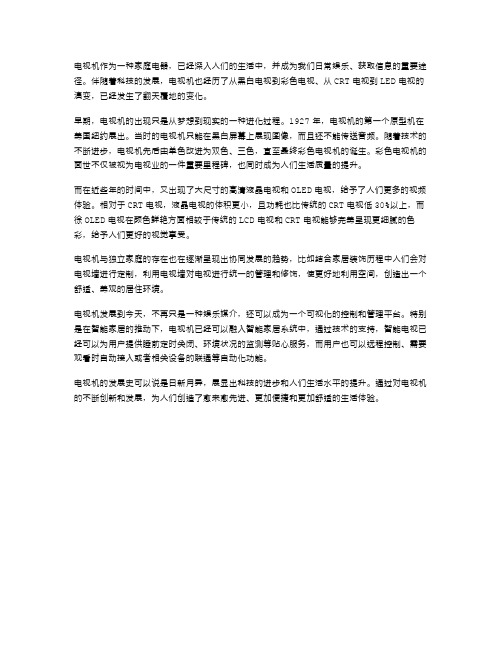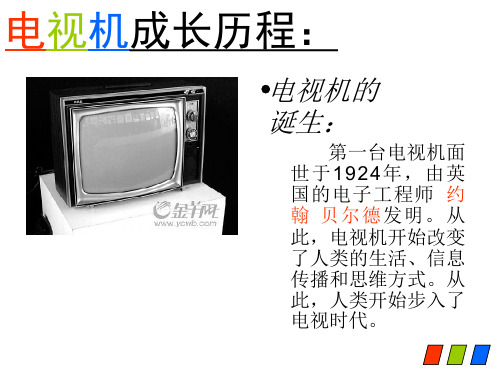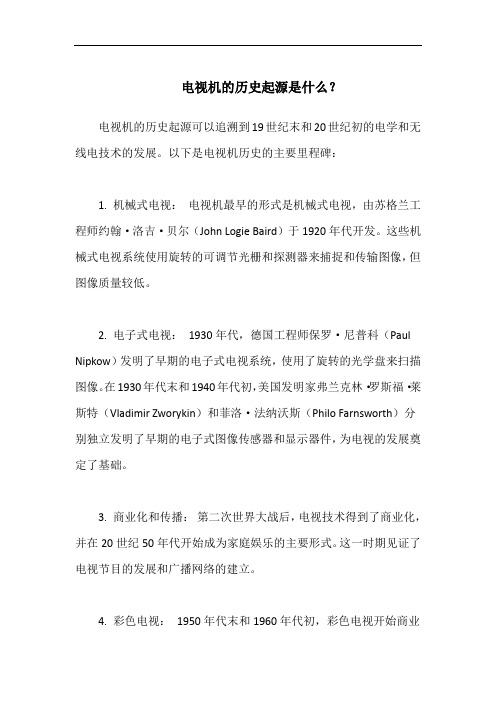电视机的发展历史
我国电视机的发展历史

我国电视机的发展历史【家电英才网提供】第一台电视机面世于1924年,由英国的电子工程师约翰·贝尔德发明,到1928年,美国的RCA电视台率先播出第一套电视片《FelixTheCat》,从此,电视机开始改变了人类的生活、信息传播和思维方式。
从此创维电视,人类开始步入了电视时代。
——从黑白到彩色、从模拟到数字、从球面到平面,我国彩电业起步于70年代中期,至今已经历了三个历史时期,即70年代中期至80年代初期的导入期,80年代中期至90年代初期的成长期,心脏90年代中后期的成熟期。
我国第一台黑白电视机诞生在1958年。
在大跃进热潮中,天津712厂彩国产电子管心脏一部分当时苏联的元器件生产出了北京牌14英寸黑白电视机。
当时我国电视机研制技术与日本基本处在同一起跑线。
1970年12月26日,我国第一台彩色电视机在同一地点诞生,从此拉开了中国彩电生产。
但由于受当时经济条件的限制,心脏政治形势的影响,70年代我国彩电定的发展缓慢,降彩电显像管等关键部件仍需要进口外,生产规模,产量,性能,质量等方面与同期已进入高速发展的日本相比,差距明显拉大。
70年代未、80年代初我国彩电事业乘改革开放的东风,在自力更生基础上,遵循以市场换技术的指导方针,与国外合作,彩世界先进技术和设备来发展自己的民族彩电工业。
1978年,国家批准引进第一条彩电生产线,定点在原上海电视机厂即现在的上广电集团。
1982年10月份竣工投产,接着我国彩电工业摆脱了自行摸索的阶段,缩短了与国外彩电技术的差距。
不久,国内第一个彩管厂咸阳彩虹厂成立。
这期间我国彩电业迅速升温,并很快形成规模,全国引进大大小小彩电生产线100多条,并涌现也熊猫、金星、牡丹、飞跃等一大批国产品牌。
1985年我国电视机产量已达1663万台,超过了美国,仅次于日本,成为世界第二的电视机吊架电视生产大国。
这期间国产品牌无论是技术还是规模都有了长足的进步,仅长虹的产量就已达到单班日产1500台,但是由于我国电视机市场受结构、价格、消费能力等条件的限制,电视机普及率还很低,城乡每百户拥有电视机量分别只有1702台和0.8台。
《日新月异的电视机》教案:电视机的发展史

电视机作为一种家庭电器,已经深入人们的生活中,并成为我们日常娱乐、获取信息的重要途径。
伴随着科技的发展,电视机也经历了从黑白电视到彩色电视、从CRT电视到LED电视的演变,已经发生了翻天覆地的变化。
早期,电视机的出现只是从梦想到现实的一种进化过程。
1927年,电视机的第一个原型机在美国纽约展出。
当时的电视机只能在黑白屏幕上展现图像,而且还不能传送音频。
随着技术的不断进步,电视机先后由单色改进为双色、三色,直至最终彩色电视机的诞生。
彩色电视机的面世不仅被视为电视业的一件重要里程碑,也同时成为人们生活质量的提升。
而在近些年的时间中,又出现了大尺寸的高清液晶电视和OLED电视,给予了人们更多的视频体验。
相对于CRT电视,液晶电视的体积更小,且功耗也比传统的CRT电视低30%以上,而徐OLED电视在颜色鲜艳方面相较于传统的LCD电视和CRT电视能够完美呈现更细腻的色彩,给予人们更好的视觉享受。
电视机与独立家庭的存在也在逐渐呈现出协同发展的趋势,比如结合家居装饰历程中人们会对电视墙进行定制,利用电视墙对电视进行统一的管理和修饰,使更好地利用空间,创造出一个舒适、美观的居住环境。
电视机发展到今天,不再只是一种娱乐媒介,还可以成为一个可视化的控制和管理平台。
特别是在智能家居的推动下,电视机已经可以融入智能家居系统中,通过技术的支持,智能电视已经可以为用户提供睡前定时关闭、环境状况的监测等贴心服务,而用户也可以远程控制、需要观看时自动接入或者相关设备的联通等自动化功能。
电视机的发展史可以说是日新月异,展显出科技的进步和人们生活水平的提升。
通过对电视机的不断创新和发展,为人们创造了愈来愈先进、更加便捷和更加舒适的生活体验。
中外电视发展史

第八节中外电视发展史一世界电视发展史1电视的发明(1)硒的“光电效应”1817年,瑞典科学家布尔兹列斯发现了化学元素硒Se。
1865年,英国工程师约瑟夫·梅发现硒有“光电效应”。
1884年德国科学家保罗•尼普柯运用硒的光电效应发明了一种用机械的方法来实现分割图象和轮流传送的器械,即圆盘机械电视。
(2)贝尔德—机械式扫描电视发明者1926年贝尔德完成电视画面的完整组合及播送,1月26日在伦敦作公开示范表演,被称为“电视之父”。
1928年贝尔德将电视画面由伦敦发送到格拉斯和纽约。
1930年,英国广播公司和贝尔德合作,试验成功了有声的电视图像及其传送。
然而,机械电视具有设备太笨重、噪音太大、不易操作等缺点。
(3)电子(全电动)电视的出现1923年俄国人佐里金(1919年移民美国)发明电子摄像管——是全电动电视的关键部分。
1927年,美国科学家菲洛·法恩斯沃斯展示了他的图像分解仪。
1929年7月,他研制出第一个全电动电视系统,同年9月,他终于成功传送了静止图像——幅黑色三角形的图案,1946年,美国第一次播出全电子扫描电视,从此,电视由机械扫描时代进入到电子扫描时代。
(4)机械电视与电子电视的区别第一,一是现代电视图像的摄像和显示不再靠机械转动,而是用电子束扫描靶标。
被摄的影像通过摄像机的镜头,投射在摄像管底部的硒板上,通过电子束扫描,记录下图像映射在硒板上的光线变化。
显像时再通过电子束扫描,在荧光屏上还原光线的变化,形成图像。
第二,二是现代电子扫描技术的扫描方式不再是螺旋形,而改为从上到下、从左到右一行一行地进行扫描,每一行都包括数以千计的扫描点。
而且摄取和显示图象的扫描运动完全同步进行。
第三,是电子扫描比机械扫描快得多,而且电子扫描可以做到行多、点多,将图象分解的颗粒更细,并进行精确控制,因此它产生的图象要更清晰、稳定。
(5)电视的成型1936年英国在伦敦亚历山大宫建立世界上第一座电视台BBC。
电视发展历程范文

电视发展历程范文
电视机是人们普遍家用的一种重要电器,而电视的发展历史可以追溯
到1880年。
1880年,意大利科学家贝尔第一次演示了一台能够收看画面
的机器,他发明的电视机可以把图像转换成电信号,但这种技术当时并没
有得到进一步发展。
1927年,美国物理学家乔治·希尔首次演示了一台
能够收发静态画面的电视机,但画面模糊不清,影响了此后电视发展的推进。
1935年,美国牛津大学研究生查尔斯·斯蒂芬斯发明了棱镜扭曲管,它是一种能够在电磁辐射中产生优秀画面的元件。
在此基础上,英国物理
学家约翰·斯特劳斯发明了钆铜管,这种管子使电视图像更加清晰。
借助
斯特劳斯的发明,英国物理学家亚伯斯·布莱克实现了电视接收器的商业
化生产,1935年英国第一台商业化电视接收器问世,标志着电视发展进
入另一个阶段。
1936年,美国发明家罗伯特·帕尔莫及其向导林肯·普罗比发明了
能够传输彩色画面的彩色电视电路,但当时各国尚未普及这种技术。
此外,英国物理学家弗朗西斯·卡尔·迪斯克发明了晶体管,它的出现取代了热管,为未来电视技术的发展提供了基础。
此外,1941年。
电视的发展历史

电视的发展历史电视的发展历史一、电视技术的起源电视技术的发展可以追溯到19世纪末,当时科学家们开始探索如何将图像转化为电信号并传输到远处。
1884年,德国科学家尼普科夫发明了世界上第一台扫描装置,这种装置可以将图像分解成许多细小的像素,每个像素都被一个光点照亮,然后通过旋转的凸透镜将光点扫描到一个硒光电池上,从而产生电流。
这个过程被称为“尼普科夫扫描”。
二、电视技术的早期发展在20世纪初,英国科学家约翰·洛吉·贝尔德发明了第一台电视机,它使用尼普科夫扫描和无线电信号传输图像。
这个电视机被称为“机械电视”,因为它使用机械部件来扫描和传输图像。
随着时间的推移,电子技术的进步使得电视机变得更加可靠和实用。
三、彩色电视技术的出现在20世纪50年代,彩色电视技术开始出现。
早期的彩色电视机使用阴极射线管(CRT)作为显示器件,这种技术可以产生高质量的彩色图像。
随着时间的推移,更多的电子技术被应用到电视领域,例如集成电路和数字信号处理技术,这些技术使得电视机更加轻便、清晰和可靠。
四、液晶电视和等离子电视的兴起在21世纪初,液晶电视和等离子电视开始兴起。
这两种技术都可以将图像显示在平坦的面板上,而不需要使用CRT。
液晶电视利用液晶材料的变化来控制光的透过和反射,而等离子电视则使用等离子气体来发光。
这些技术使得电视机更加轻薄、节能和环保。
五、智能电视和互联网电视的发展随着互联网技术的不断发展,智能电视和互联网电视开始普及。
这些电视机具有先进的处理器和操作系统,可以连接到互联网并运行各种应用程序,例如在线视频流媒体平台、社交媒体和游戏。
此外,智能电视还可以与其他智能家居设备连接,从而形成一个智能家居控制系统。
六、3D电视和4K超高清电视的推出近年来,3D电视和4K超高清电视相继推出。
3D电视可以显示立体的图像,使观众能够感受到更真实的视觉效果。
而4K超高清电视则具有更高的分辨率和更细腻的图像细节,使得观众可以在更近的距离下观看图像而不会出现模糊或失真。
电视机发展史

电视发展史
电视媒体历史沿革
电视机经历了从黑白到彩色,从电子管、晶体管电 视迅速发展到集成电路电视,目前,电视正在向智 能化、数字化和多用途化迈进;电视转播也由卫星 传播到卫星直播。
电视机发展史
世界上第一台机械电视
1880年,法国人莱布朗克提出使一个镜面在两个不同轴线上以不同速 度振动,形成往返直线扫描,从而对图像进行分解和再现。 1883年圣诞节 德国电气工程师尼普柯夫用他发明的“尼普柯夫圆盘 ”使用机械扫描方法,作了首次发射图像的实验。每幅画面有24行线 ,且图像相当模糊。 1897年,德国的布劳恩发明阴极射线管以显示快速变化的电信号; 1904年,英国人贝尔威尔和德国人柯隆发明了一次电传一张照片的电 视技术,每传一张照片需要10分钟。 1908年 英国肯培尔.斯文顿、俄国罗申克无提出电子扫描原理,奠定 了近代电技术的理论基础。
DuMont1948年产品,看 起来像个小狗舍吗?
1948年Zenith产彩色电视 机,次年被当作医疗监控 设备使用
•1949年,美国首次研制出世界上第一只 三枪三束彩色显像管; 1949年12月17日 开通使用第一条敷设在英国伦敦与苏登.可 尔菲尔特之间的电视电缆。
1949年,彩色电视机投入使用, 图为CBS电视网用其播放医疗手 术实况
电子管电视
1923年,美籍苏联人兹瓦里金发明静电积贮式摄像管申请 到光电显像管、电视发射器及电视接收器的专利,他首次采 用全面性的“电子电视”发收系统,成为现代电视技术的先 驱。电子技术在电视上的应用,使电视开始走出实验室,进 入公众生活之中。 19世纪末,少数先驱者开始研究设计传送图像的技术。 1924年,英国和德国科学家几乎同时运用机械扫描方式成功 地传出了静止图像。但有线机械电视传播的距离和范围非常 有限,图像也相当粗糙。
电视机的历史(第一章)

1.1.1电视的诞生电视诞生于20世纪40年代,其发展是十分迅速的。
美国于1920年首先研试电视机,1936年英国开始在伦敦建立第一座电视台。
1940年美国造出了世界上第一台电视,并于1941年播放了第一条商业电视广告。
彩色电视机则于1954年问世。
1953年2月,日本NHK电视台首播,同年8月NTV商业电视台正式开播,这是亚洲第一个商业电视台。
1958年5月1日晚7时,北京电视台(中央电视台前身)试播成为中国大陆电视的诞生日,同年9月2日正式播出。
返上1.1.2电视的发展20世纪50年代国际电视业的迅速发展也带动了我国电视业的发展。
以上海为例,1958年4月上海市政府下达研制任务,上海广播器材厂不分昼夜进行研制,并于同年7月24日完成,收到"中心发射台"发射的多种几何图形组成的表格。
测定表明,其质量和稳定度超过了当时中国市场上的日本"通用牌"和前苏联的"红宝石牌"电视。
现在,"中国第一代电视机"已经入藏历史博物馆,这就是上海牌101 型43 厘米(17寸)电子管。
中央电视台于1972年5月正式播出彩色电视节目,上海电视台则于同年10月播出彩色电视节目。
返上1.1.3数字电视迅速崛起在我国国庆50周年的日子里,数字电视试播成功。
之后,深圳、常州等地也进行了小规模数字电视试播。
作为与北京、深圳同步试验发展数字电视的上海,则在2000年开通了数字电视,其中增补27频道的一路高清晰度数字电视节目(频率:379MHZ、符号率:6835 、调制方式:16QAM );并实验其他频道的数字电视节目的传输。
2001年的APEG期间,上海主要宾馆开通数字电视节目。
2002年元月,上海开通数字有线电视节目频道,此时上海电视台的数字化程度已达45%,并计划两年内完成从模拟到数字的转换;两年后实现无磁带化硬盘播出。
2002年9月28日,上海试播30套数字电视节目(全国第一)。
电视机发展历史

电视机成长历程:电视机的诞生:第一台电视机面世于1924年,由英国的电子工程师约翰·贝尔德发明。
从此,电视机开始改变了人类的生活、信息传播和思维方式。
从此,人类开始步入了电视时代。
电视机的黑白时代:•第一代黑白电视机,采用晶管体技术,极大丰富了人类生活,改变了文化传播方式。
只能显示黑白画面,而且屏幕较小,观看时人们遇调好频率,和电台,体积也较为笨重。
电视机的彩屏时代:•1973年,开始试播彩色电视。
1973年,数字技术用于电视广播,实验证明数字电视可用于卫星通信。
彩色电视的出现无疑是电视划时代的演变,人们变得越来越离不开它,彩屏电视能更客观更真实地传达事物,娱乐性也是黑白电视无法比拟的!彩色电视体积也相对较大,笨重,经历了凸屏到纯品的演变,画质也越来越细腻,随着红外线技术的发展,也催生了电视遥控器的产生,人们操作起来也越来越方便了!电视机的液晶纯平时代:•这一时代的电视走向了更轻.更薄.更清晰的时代,向又大又笨重的1973年,开始试播彩色电视。
大彩屏时代告别了,极大的节约了生活空间,画质也得到了空前的提升!电视机的数字智能时代:随着现代数字信息的高速发展,电视机也走向智能数字时代.更薄更大更方便画质音响更好,更智能,高端,带操作系统差不多快向电脑发展了.从平板电视到互联网电视再到3D电视,以后发展的势头很强!。
电视发展史

电视发展史电视媒体历史沿革电视机经历了从黑白到彩色,从电子管、晶体管电视迅速发展到集成电路电视,目前,电视正在向智能化、数字化和多用途化迈进;电视转播也由卫星传播到卫星直播。
电视机技术发展史19世纪末,少数先驱者开始研究设计传送图像的技术。
1904年,英国人贝尔威尔和德国人柯隆发明了一次电传一张照片的电视技术,每传一张照片需要10分钟。
1924年,英国和德国科学家几乎同时运用机械扫描方式成功地传出了静止图像。
但有线机械电视传播的距离和范围非常有限,图像也相当粗糙。
1923年,俄裔美国科学家兹沃里金申请到光电显像管、电视发射器及电视接收器的专利,他首次采用全面性的“电子电视”发收系统,成为现代电视技术的先驱。
电子技术在电视上的应用,使电视开始走出实验室,进入公众生活之中,1925年,英国科学家研制成功电视机。
1928年,美国纽约31家广播电台进行了世界上第一次电视广播试验,由于显像管技术尚未完全过关,整个试验只持续了30分钟,收看的电视机也只有十多台,此举宣告了作为社会公共事业的电视艺术的问世,是电视发展史上划时代的事件。
1929年美国科学家伊夫斯在纽约和华盛顿之间播送50行的彩色电视图像,发明了彩色电视机。
1933年兹沃里金又研制成功可供电视摄像用的摄像管和显像管。
完成了使电视摄像与显像完全电子化的过程,至此,现代电视系统基本成型。
今天电视摄影机和电视接收的成像原理与器具,就是根据他的发明改进而来。
电视机发展史世界上第一台机械电视1880年,法国人莱布朗克提出使一个镜面在两个不同轴线上以不同速度振动,形成往返直线扫描,从而对图像进行分解和再现。
1883年,德国人尼普科夫提出了圆盘扫描法;1897年,德国的布劳恩发明阴极射线管以显示快速变化的电信号;1904年,英国人贝尔威尔和德国人柯隆发明了一次电传一张照片的电视技术,每传一张照片需要10分钟。
电子管电视1923年,俄裔美国科学家兹沃里金申请到光电显像管、电视发射器及电视接收器的专利,他首次采用全面性的“电子电视”发收系统,成为现代电视技术的先驱。
1925-1985年,电视机的发展史,你所不知道的历史时刻

1925-1985年,电视机的发展史,你所不知道的历史
时刻
展开全文
二战的爆发使得刚发展起来的电视的发展停滞了10年。
战争结束后,电视工业又蓬勃发展起来,电视也迅速流行起来。
1937年,英国广播公司(BBC)终止使用这种技术。
因为在那时电子式电视系统更受欢迎。
1955年8月25日,哈罗公社的模特玛格丽特·史密斯手提便携式电视机的场景。
1958年,中国的国营天津无线电厂,制造出了中国的第一台黑白电视机。
1939年,美国人发明了第一台黑白电视机。
1985年,电视机售卖商店内,人们排着队等待购买电视机。
1970
年也是在同样的厂房诞生了中国第一台彩色电视机。
第一个半机械式模拟电视系统在1925年10月2日被苏格兰人约翰·洛吉·贝尔德在伦敦的一次实验中“扫描”出木偶的图像看作是电视诞生的标志,他被称做“电视之父”。
后来,他的这个系统被英国广播公司所采用。
1978年,上海电视机厂引进了第一条彩电生产线,1982年开始投产。
1939年,英国大约有2万个家庭拥有电视机,美国无线电公司的电视也在纽约世博览会上首次露面,开始第一次固定的电视节目演播。
1934年8月25日法恩斯沃斯在宾夕法尼亚州费城的富兰克林学会首次给全世界演示一套完整的全电子电视系统。
电视机的发展历史(教学课件)

告了作为社会公共事 业的电视艺术的问世, 是电视发展史上划时 代的事件。
1928年通用电气公司制造 的这个可爱小木柜被公认 为最早的声画交互设备。
1929年美国科学家伊 夫斯在纽约和华盛顿之间 播送50行的彩色电视图像, 发明了彩色电视机。1933 年兹沃里金又研制成功可 供电视摄像用的摄像管和 显像管。完成了使电视摄 像与显像完全电子化的过 程,至此,现代电视系统 基本成型。今天电视摄影 机和电视接收的成像原理 与器具,就是根据他的发 明改进而来。
1933年兹沃里金又研制成功可供电视摄像用的 摄像管和显像管。完成了使电视摄像与显像完全 电子化的过程,至此,现代电视系统基本成型。 今天电视摄影机和电视接收的成像原理与器具, 就是根据他的发明改进而来。
1935年,贝尔德与德国公司合作,成立了第一 家电视台,每周播放三次节目。1936年;英国播 送当时全世界最清晰的公共电视节目;
报电话公司的远距离信号传输装置 进行对话。
1927年美国电报电话公司首台远距 离信号传输装置。
法国人Rene Bartholemy于1928 年设计的“Semivisor”。
1928年,英国Baird公司生产了首 台面向消费者的商用电视机。
1937年美国电报电话公司的同轴电 缆传输测试设备。
第二次世界大战后美国电视事业发展 超 过 英 国 : 从 1949 年 到 1951 年 , 电 视 机数目从1百万台跃升为1千多万台, 1960年全美电视台高达780座,电视机 近三千万台,约有87%的家庭拥有至 少一台电视机。同时期英国只有190万 台电视机,法国3万台,加拿大2万, 日本4千台。1993年底,美国98%的家 庭拥有至少一台电视机,其中99%为 彩色电视机。
电视机的历史起源是什么

电视机的历史起源是什么?电视机的历史起源可以追溯到19世纪末和20世纪初的电学和无线电技术的发展。
以下是电视机历史的主要里程碑:1. 机械式电视:电视机最早的形式是机械式电视,由苏格兰工程师约翰·洛吉·贝尔(John Logie Baird)于1920年代开发。
这些机械式电视系统使用旋转的可调节光栅和探测器来捕捉和传输图像,但图像质量较低。
2. 电子式电视:1930年代,德国工程师保罗·尼普科(Paul Nipkow)发明了早期的电子式电视系统,使用了旋转的光学盘来扫描图像。
在1930年代末和1940年代初,美国发明家弗兰克林·罗斯福·莱斯特(Vladimir Zworykin)和菲洛·法纳沃斯(Philo Farnsworth)分别独立发明了早期的电子式图像传感器和显示器件,为电视的发展奠定了基础。
3. 商业化和传播:第二次世界大战后,电视技术得到了商业化,并在20世纪50年代开始成为家庭娱乐的主要形式。
这一时期见证了电视节目的发展和广播网络的建立。
4. 彩色电视:1950年代末和1960年代初,彩色电视开始商业化,美国于1954年推出了首台彩色电视机。
5. 平板电视:20世纪90年代后期和21世纪初,液晶显示(LCD)、等离子显示(PDP)、有机发光二极管(OLED)等平板显示技术的发展推动了平板电视的兴起,使电视机体积更小、更轻薄,并且提高了图像质量。
6. 高清晰度和数字电视:21世纪初,高清晰度(HDTV)和数字电视技术逐渐成熟,提供更高分辨率的图像和更清晰的音频,逐渐取代了传统的模拟电视。
7. 智能电视和互联网电视:随着互联网和智能手机的普及,电视机逐渐智能化,具备了与互联网连接的功能,可以访问在线视频、社交媒体等应用,成为家庭娱乐和信息娱乐的综合中心。
总的来说,电视机的历史起源于早期的机械式和电子式技术,经过了多年的发展和演进,如今已成为现代家庭中不可或缺的重要娱乐和信息传播工具。
电视发展史

三、电视机技术发展1.开山鼻祖:CRT显像管电视显像管电视的成像原理简单的说就是通过电子枪发射电子束,利用电磁立场对电子束的偏转作用控制电子的方向来轰击荧光屏上荧光粉,从而产生图象。
CRT显像管的发明不能归功于某个人或某个国家,从1883年尼普柯夫第一次尝试传输图像到1923年发明电子扫书描式显像管直至1925年第一台电视的试播,其中承载了多国科学家的不解努力。
早期显像管电视CRT背投彩色电视与投影管CRT背投电视的成像原理从根本上与显像管相同,不同在于普通彩电收LCD液晶背投与外光源灯泡背投电视的出现满足了人们对电视“更大、更清晰、更省的地方”的要求,不过这种显示方式的缺点也很明显,背投技术的高成本一度使背投电视成为有钱人的专用品,并没有真正走进百姓家庭,20000小时左右的寿命也不能满足家用而高昂的维修费用也成为背投电视被舆论诟病的地方。
等离子电视成像原理示意图等离子电视中的每一个等离子腔体都是一个单独的像素点,所以理论上只要像素点足够小,等离子电视的像素可以无限高,这样就打破了CRT电视清晰度液晶电视液晶电视是目前主流平板电视市场的另一重要组成部分,LCD液晶电视的目前世界最大尺寸液晶电视平板电视是目前电视产业中绝对的主角,如果说早期的背投淘汰显现管是人们一厢情愿的话,那么现在看来平板电视全面替代CRT电视则是大势所趋。
LED液晶电视是依托液晶技术经过改良背光源后推出的新一代产品。
前面提到过液晶电视的成像是需要光源支持的,为传统的液晶电视提供光源的是冷凝式灯管,这种灯管寿命短、发光质量差,不能还原出优秀的画面。
而采用LED 背光照明后色域和对比度被扩大,色彩效果有明显的提升,画面显示更加真实、自然。
由于LED背光源的体积比冷凝式灯管小,所以LED液晶电视的厚度进一步减小。
OLED液晶电视OLED液晶应用于手机等小屏幕产品时间较早,最近才被应用到电视制造领域。
其成像原理是在原有液晶板电极之间夹上有机发光层,当正负极电子在此有机材料中相遇时就会发光,从而成像。
电视的发展史

电视的发展史
电视机经历了从黑白到彩色,从电子管、晶体管电视迅速发展到集成电路电视,目前,电视正在向智能化、数字化和多用途化迈进;电视转播也由卫星传播到卫星直播。
回顾历史:1928年,英国Baird公司生产了首台面向消费者的商用电视机。
1948年Baird 研制出12英寸Lyric电视机。
英国于1950年前后出品的9英寸电木外壳电视机。
从此,电视机正式走进“平民家”。
1951年Sony为美国市场生产的第一台电视机,规格为8英寸。
电视机走向世界。
感动中国:我国在1958年研制成功第一台黑白电视机北京牌14英寸黑白电视机,1970年12月26日,我国第一台彩色电视机在同一地点诞生。
并在1974年开始拥有“有线技术”。
2002年,我国“长虹”宣布研制成功了中国首台屏幕最大的液晶电视。
其屏幕尺寸大大突破22英寸的传统业界极限,屏幕尺寸达到了30英寸,当时被誉为“中国第一屏”。
展望未来:现代电视系统基本成型,今天电视摄影机和电视接收的成像原理与器具,更具便捷化,更加智能化。
安民学校东八间校区三(1)班。
电视发展历史

从黑白到高清电视发展历程电视作为人们日常生活中常见的娱乐工具,发展历程十分丰富多彩。
从最初的黑白电视,到彩色电视,再到今天的高清电视,电视技术不断的发展。
下面就为大家介绍电视从黑白到高清的发展历程。
20世纪50年代至60年代初期是黑白电视的主流时期。
当时的电视机体积庞大、通体黑白,屏幕分辨率较低,只能接收少量的电视频道。
由于当时的电视信号还是模拟信号,而且地理环境和地形的影响会导致电视信号扭曲或干扰,所以很多观众家庭也只能看到模糊不清的电视画面。
到了20世纪60年代末期,彩色电视开始进入人们的视野。
彩色电视的出现使得人们可以看到更加丰富多彩的生活画面。
彩色电视屏幕的色彩饱和度比黑白电视屏幕更高,但是屏幕分辨率还是比较低。
了解电视发展历程,我们还要提到数字电视。
20世纪90年代末期以后是数字电视广泛应用的时期。
随着数字技术的推广,电视信号逐渐由模拟信号向数字信号转变。
数字技术的应用,改善了信号传输的稳定性和画质,解决了信号扰动的问题。
同时数字电视的出现,使得观众可以选择更多的电视频道,自由组合自己喜欢的节目。
最新的电视技术是高清电视,高清电视屏幕的分辨率很高,甚至可以达到4K、8K的分辨率,清晰度和色彩还原度都大大提升。
同时,高清电视使用的是数字信号,不会受到与模拟信号相同的干扰影响。
高清电视技术的应用,让观众可以更好地享受大屏幕电视带来的震撼感受。
总的来说,电视技术随着科技的发展而不断进步。
从黑白电视到高清电视,电视行业在不同的发展阶段,推出的创新电视技术,都为观众提供了更加清晰、真实、丰富的视觉体验。
电视发展历史总结汇报材料

电视发展历史总结汇报材料电视发展历史总结汇报材料:电视是一种重要的大众媒体,为人们提供了丰富的信息和娱乐。
本文将从电视的起源、发展到现代电视技术的进展,总结电视发展的历史。
1. 电视的起源电视的起源可以追溯到19世纪末。
1897年,英国物理学家亚当斯琼斯发明了一种能够转换光的电信号的设备,被认为是电视技术的先驱。
此后,一系列类似的发明逐渐改进了电视技术。
1939年,德国工程师保罗·恩斯滕发明了第一台电视机,成为电视发展史上的重要里程碑。
同年,美国也开始在纽约举办首次电视试播。
电视的问世引发了全球对于电视技术的兴趣与研究。
2. 电视的发展在第二次世界大战之后,电视技术得到了进一步的发展。
电视信号的传播从最初的有线电视向无线电视转变,为人们提供了更大的便利。
1954年,日本发明家黑川正德发明了世界上第一台彩色电视机。
彩色电视机的问世使电视节目的画质更加生动逼真,也吸引了更多的观众。
此外,1964年,测试仪和集成电路的引入,使电视机的尺寸更小,功能更强大。
20世纪70年代和80年代,电视技术迎来了数字化的转型。
1980年,法国的世界通信协会研发出了第一个数字图像压缩算法,使电视信号传输更加稳定、清晰。
1996年,美国电视标准委员会(ATSC)发布了数字电视标准,开启了数字电视技术的全面发展。
3. 现代电视技术的进展21世纪,随着科技的不断进步,电视技术也得到了颠覆性的变革。
高清晰度(HD)电视成为了主流,并逐渐演进为超高清晰度(UHD)和8K电视。
另外,互联网的普及和高速网络的发展,使得电视与互联网融合发展。
利用智能电视和电视盒子,观众可以通过网络观看各种各样的内容,如视频网站、电视直播、视频点播等。
电视已不再是单纯的接收器,而是成为一个庞大的娱乐平台。
此外,虚拟现实(VR)和增强现实(AR)技术的出现,为电视节目提供了全新的观看体验。
观众可以通过佩戴VR头盔或使用AR技术,将电视内容与现实世界结合起来,获得更加沉浸式的观看效果。
《电视机的发展历史》课件

电视机的发展
黑白电视机的出现
50年代,黑白电视机被广泛普及。开始成为家 庭的常规娱乐器材。
平板电视机的兴起
21世纪以来,随着电视技术的不断升级,越来 越多的平板电视机问世。
彩色电视机的问世
彩色电视机的出现让电视机具有了更好的观赏 性。充分满足了人们对色彩的需求。
曲面电视机的应用
曲面电视机的问世,让电视机不再只是简单的 平面,而是更立体、更生动。显然更具观赏性。
结论
电视机的发展历史与技 术进步
电视机发展至今已经走过了 漫长的历程。技术的升级也 让电视机功能更加多元化, 成为现代社会不可或缺的部 分。
电视产业的发展现状与 趋势
电视产业发展到了今天,已 经不再像早期那么简单。而 是面临着更多元化的发展趋 势和挑战。
电视文化的影响与重要 性
电视文化既是现代社会美好 价值观的传承者,也是国家 文化传播的重要方式。越来 越多的人都需要具备高品质 的电视文化素养。
电视产业的发展
电视机品牌的竞争与合并
电视机市场的变化与趋势
电视机是电子产业中一个极为重 要的品类。各大品牌间的激烈竞 争与合并,让电视产业更加成熟。
互联网与电视的结合,让电视机 逐渐具备了更多元化的功能,市 场呈现出不断变化的趋势。
电视机的未来发展方向
未来电视机将会越来越智能化, 加强与互联技术的融合。具备 更多多元化的、个性化的功能。
电视文化的影响
1
电视节目与电视文化的演变
随着电视技术不断升级,其节目形式也
电视鉴赏与电视素养的提高
2
在不断演变,电视节目的多样化呈现出 不断加强的趋势。
电视文化也利用电视为人们提供文化体
验。同时,电视文化也需要观众具备观
- 1、下载文档前请自行甄别文档内容的完整性,平台不提供额外的编辑、内容补充、找答案等附加服务。
- 2、"仅部分预览"的文档,不可在线预览部分如存在完整性等问题,可反馈申请退款(可完整预览的文档不适用该条件!)。
- 3、如文档侵犯您的权益,请联系客服反馈,我们会尽快为您处理(人工客服工作时间:9:00-18:30)。
Television, or TV for short, is a telecommunication medium for transmitting and receiving moving images that can be monochrome (black-and-white) or colored, with or without accompanying sound. "Television" may also refer specifically to a television set, television program, or television transmission.As one of the greatest inventions in the 20th century, television’s development can date back to the end of 19th century. And at the beginning of television history there were two distinct paths of technology experimented with by researchers.the earlier one is Mechanical Television, and the other is Electronic Television. Early inventors attempted to either build a mechanical television system based on the technology of Paul Nipkow's rotating disks; or they attempted to build an electronic television system using a cathode ray tube developed independently in 1907 by English inventor A.A. Campbell-Swinton and Russian scientist Boris Rosing.German, Paul Nipkow developed a rotating-disc technology to transmit pictures over wire in 1884 called the Nipkow disk. Paul Nipkow was the first person to discover television's scanning principle, in which the light intensities of small portions of an image are successively analyzed and transmitted. In the 1920's, John Logie Baird patented the idea of using arrays of transparent rods to transmit images for television.Charles Jenkins invented a mechanical television system called radiovision and claimed to have transmitted the earliest moving silhouette images on June 14, 1923.Using a Nipkow disk, Scottish inventor John Logie Baird succeeded in demonstrating the transmission of moving silhouette images in London in 1925,[8] and of moving, monochromatic images in 1926. Baird's scanning disk produced an image of 30 lines resolution, just enough to discern a human face, from a double spiral of Photographic lenses.[9] This demonstration by Baird is generally agreed to be the world's first true demonstration of television, albeit a mechanical form of television no longer in use. Remarkably, in 1927, Baird also invented the world's first video recording system, "Phonovision": by modulating the output signal of his TV camera down to the audio range, he was able to capture the signal on a 10-inch wax audio disc using conventional audio recording technology.Electronic television is based on the development of the cathode ray tube, which is the picture tube found in modern TV sets. German scientist, Karl Braun invented the cathode ray tube oscilloscope (CRT) in 1897.In 1926, Hungarian engineer designed a television system utilizing fully electronic scanning and display elements, and employing the principle of "charge storage" within the scanning (or "camera") tube.On 25 December 1926, Kenjiro Takayanagi demonstrated a television system with a 40-line resolution that employed a CRT display at Hamamatsu Industrial High School in Japan.[15] This was the first working example of a fully electronic television receiver.By 1927, Russian inventor Léon Theremin developed a mirror-drum-based television system which used interlacing to achieve an image resolution of 100 lines.in 1927, Philo Farnsworth made the world's first working television system with electronicscanning of both the pickup and display devices,[18] which he first demonstrated to the press on 1 September 1928.Russian inventor, Vladimir Zworykin invented an improved cathode-ray tube called the kinescope in 1929. The kinescope tube was sorely needed for television. Zworykin was one of the first to demonstrate a television system with all the features of modern picture tubes.At the Berlin Radio Show in August 1931, Manfred von Ardenne gave the world's first public demonstration of a television system using a cathode ray tube for both transmission and reception. The world's first electronically scanned television service then started in Berlin in 1935. In August 1936, the Olympic Games in Berlin were carried by cable to television stations in Berlin and Leipzig where the public could view the games live.In 1935, the German firm of Fernseh A.G. and the United States firm Farnsworth Television owned by Philo Farnsworth signed an agreement to exchange their television patents and technology to speed development of television transmitters and stations in their respective countries.On 2 November 1936, the BBC began transmitting the world's first public regular high-definition service from the Victorian Alexandra Palace in north London.[23] It therefore claims to be the birthplace of television broadcasting as we know it today.In 1936, Kálmán Tihanyi described the principle of plasma display, the first flat panel display system.Although television became more familiar in the United States with the general public at the 1939 World's Fair, the outbreak of World War II prevented it from being manufactured on a large scale until after the end of the war. True regular commercial television network programming did not begin in the U.S. until 1948. Since the 1950s, television has been the main medium for molding public opinion.And in 1964 the world’s first Plasma Display Panel was invented, and it was used to be PLATO graphoscope at that time. In 1970s, the world’s first Liquid crystal display device was produced. And up to now, smart TV, cloud TV and network television have been invented.Next, I will talk about the TV’s features and functions. As one of the greatest inventions in the 20th century, Television is a leap in the human material culture. It has several advantages of the different medias. First, it has wide coverage. There are all kinds of news on the TV,and we can watch what we want to see. Second, it has strong timeliness. All we watch on the TV happen recently or are still happening. So we can catch up with the world’s change.Third, it has Strong sense of the scene. Some TV programs can giveus a feeling that we are just on the scene as well as the people who are present. And then I will talk about TV’s function or influences. Television has played a pivotal role in the socialization of the 20th and 21st centuries. Because of the invention of TV, we ordinary people can know what is happening or has happened in the outside world. We can know what we don’t know and what other people do in the same period. Also, the use of the television for video games, especially games such as the Wii, has contributed to a growing kin aesthetic connection between television and viewers. What’s more, television is a tool of entertainment. We can kill our dull spare time on watching TV shows or TV series. And it makes our lives become more colorful and interesting. It enrich our spiritual lives. But at the same time, here comes some drawbacks of TV shows. As the rapid development of television, the TV stations are becoming more and more utilitarian(功利化的)There are too many advertisements during the TV shows. When we are waiting for a TV show, but before it starts, there are a lot of ads before it. That is annoying. I think this is the biggest shortcoming of the television.Finally I will talk about the development of TV in the future. Along with the time progress, technology is constantly updated. People will not satisfy the current situation in the visual enjoyment, and where is the road of TV development in the future. Some people say that TV will be replaced to be eliminated. I think television is the most important part of the household appliances and will not be "abandoned". But with the development of science and technology progress, more and more to meet people's needs and feelings. And what will the future TV look like? There are some assumption: Personal smart TV, Split type television(分体式电视), Three dimensional holographic television(三维全息图像电视), organic light emitting diode(透明有机发光二极体)and so on. And what is the tend of TV’s development? I think future TV will pursue integration and lightweight,High intelligence, multi-function, combination多功能、组合化, Wall type.璧型化, Projection投影化and so on.。
